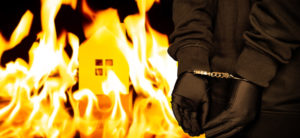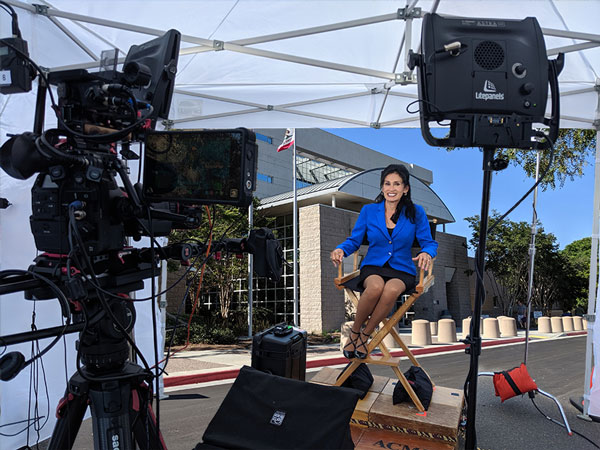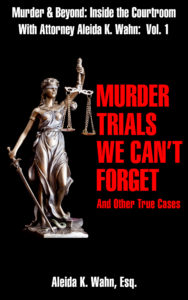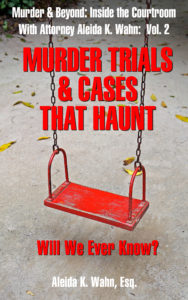
Did Wilber Romero Set the Fiery Blaze?
Wendy Romero’s hair was on fire and her desperate screams filled the night. As she stood trapped at her window her hands extended through the metal security bars flailing wildly for help. It was a ghastly scene and her neighbors, awakened from their nearby slumber, frantically rushed to save her. It was the early morning hours of October 13, 2019, and the Romero family was caught in a fiery blaze. The flames would not only envelope their once safe home, but forever change their world. One would not escape the inferno, others succumbed to injuries in hospital care. Two lived to tell. Wilber Romero would soon stand accused.
What exactly happened on that October night in the tiny Logan Heights home at 3114 Clay Avenue? Did a son deliberately set his house on fire with his family inside? Wilber Romero, now 27, is accused of doing just that and after a two-day preliminary hearing, Judge Peter Gallagher ordered Romero to stand trial. He faces life in prison if convicted of three counts of first-degree murder and two counts of arson causing great bodily injury. Additionally, the murder charges carry enhanced sentencing allegations as the deaths occurred while Romero was on felony probation.
Although a preliminary hearing is not a full trial but merely meant to determine if probable cause exists to order the accused to trial, disturbing details emerged of the horrifying night and the events leading up to it. Testimony included statements Wilber Romero previously set 12 fires, which were extinguished by his father or mother, and openly threatened to burn down his home with his family inside. Help was not sought for the young man as the family did not wish to bring shame on their family or on their son. If these facts are indeed true, could there be a time when no stigma exists in seeking psychological help for one in need? Could society be accepting of mental health treatment as freely as medical care for a physical ailment is embraced? Yet whatever treatment might have been rendered or whether the fatal fire could have been prevented was not a matter to be determined in this legal proceeding but was left solely to contemplation.
As it stood, whether the fire was intentionally set or accidental was a fact the arson inspector could not definitively state, though concluding the fire started on Wilber’s bed. As key questions await answers, what is certain is this: Wilber’s father, Jose Antonio Romero, 46, perished in the fire and Wilber’s mother, Nicolasa Mayo-Romero, 46, died the following day. Wilber’s younger sister, Iris Kristal Romero, 21, was determined brain dead after unsuccessful resuscitation efforts and died at the hospital after two days. Wendy Romero, 24, was the fortune one, whose screams brought neighbors to her rescue. Heroically they broke down the front door to pull her to safety and extinguished the flames burning her hair and back. Her injuries were extensive, and she spent weeks in the intensive care burn unit of U.C. San Diego Medical Center. The youngest son, Angel, 17, jumped out of a window and ran to a friend’s home four blocks away. He too would spend time in the intensive care burn unit. Wilber alone was found unharmed. He stood outside the home with the family dog. Wilber Romero was 26-years-old at the time.

In the days following the fire, Wilber spoke candidly to news reporters, firmly denying any involvement with the fire, instead insisting he tried to save his family, but was forced to save himself. When further pressed he said, “You can lock me up, but you’re not going to take me in to say this, ‘I did it.’ I am not going to say it because I know I didn’t do it.”
Despite his protestations of innocence, Wilber was arrested on October 18, 2019, five days after the fatal blaze. As his preliminary hearing got underway on September 30, 2020, Wilber appeared via video conferencing with his attorney, Deputy Public Defender Neil Besse. With the COVID-19 pandemic still in full swing, in-person court hearings gave way to video proceedings. Deputy District Attorney Rikole Santin began calling witnesses, and they all appeared on screen, from a fire captain to homicide detectives to an arson inspector.
A Fire Captain Describes a Tragic Scene
Captain Kelly was the supervising fire investigator, who arrived at the scene at 5:05 a.m. He could see the fire still burning and described how firefighters worked to free victims. One victim was found in a bedroom in the fetal position. She was burned on 27% of her back and was unconscious. They took her out to the street and performed CPR. Another victim was found under a bunch of clothes with a chair on top of her. They also took her out to the street and performed CPR. An adult male was found in front of the sliding glass door. They could do no more for him as he was deceased. It was a heartbreaking scene without a doubt.
As soon as Captain Kelly was informed by Captain Cisneros that a bystander said the fire was intentionally set, he shut down the scene and waited the arrival of the homicide team.

Wilber Romero Was Not Distraught or Upset Declares One Detective
San Diego Police Detective Gary Phillips of the Metro Arson Strike Team (M.A.S.T.) arrived at the scene at 5:11 a.m. The fire was still burning, and it was a chaotic scene. He testified he spoke with Wilber Romero who had a large husky with him. “He wasn’t distraught or upset, he was just quiet,” said Detective Phillips. “I attempted to talk to him, but he was speaking way too low. He didn’t appear to be crying. He wasn’t upset.” There was no odor of smoke on Wilber’s body, although Detective Phillips detected a bad body odor, like someone who had not showered and noted his clothes were dirty. Neither did he see any soot, ash, burns, or other injuries on Wilber’s body. Detectives Phillips went on to testify about the day Wilber was arrested, stating the arresting officer said Wilber removed a silver lighter from his front pocket.
Detective Phillips went to U.C. San Diego Medical Center where he saw Wendy in the intensive care burn unit. She was on pain medication and had burns to her scalp, right arm, and neck. She spoke very low and was constantly coughing. She had difficulty breathing, which set off the alarm three times necessitating medical care, and he had to end the interview. While still in the intensive care unit, he went into Angel’s room and saw he was intubated and unconscious. He went into Nicolasa’s room and also found her intubated and unconscious. He saw her face was burned and she appeared to be burned most everywhere.
A Detective Finds a Disturbing Sign. Did Wilber Romero Write It?
San Diego Police Detective Kevin Iwasaki was assigned to the homicide unit and he went to the Romero home on October 16, 2019. He found the house boarded up, so could only inspect the outside. In the front yard he found a doghouse filled two and a half feet high with debris, including wires, tools, clothes, and mail. In the jumbled mess, he found a plastic sign with the words, “Fuck OrFamily.” What did this mean? Was the “or” misspelled and supposed to mean “Our family. Your Family” questioned attorney Besse in his subsequent cross-examination. Detective Iwasaki did not know. No one really knew what the message meant continued Besse. Neither did anyone know who wrote it, or when it was written.
On October 17, 2019, Detective Iwasaki returned to the house, and this time he was permitted inside. The house was a mess as the landlord was moving things out, and he described the scene as a “hoarder house.” He saw a red and green gas can, which he lifted and smelled gas.
Detective Iwasaki spoke to neighbor Jose B. who told him he had gone to sleep about 2:00 a.m. and awoke about 4:00 a.m. when he heard people screaming. He got dressed and went to the house. He saw fire and a female screaming with her arms out for help. He picked up a piece of cement or rock and tried to break down the door. Another person arrived and kicked the door open. He pulled the female out and a neighbor used a hose to put water on her. He saw Wilber standing at the corner.
On cross-examination, attorney Besse clarified Jose saw Wilber two houses from the corner and he was walking the family dog. Besse also got Detective Iwasaki to agree he had never seen the house before the fire and the mess could have been attributed solely to the fire and later digging through.
Detectives Describe Their Interviews with Neighbors
San Diego Police Detective Ryan Seemer of the homicide team talked to neighbor Behanna, who said he heard people screaming for help. He saw fire in the southeast corner and used a razor to break the front door. He also broke a window and heard coughing. He presumed it was the father. He went back to his house to retrieve his shoes, but when he returned, the fire had spread to the entire house and law enforcement would not allow him inside.
San Diego Police Detective James Barrera of the homicide team interviewed Brian D. who said he was driving down the street as he lives nearby and stopped to help. He moved a bed out of the way to get one victim out. Another guy was trying to break the window with a rock. The daughter was screaming and trapped at the window which had bars on it. He broke the door in half and saw the daughter with her hair and back on fire. He used a hose and also patted her back to put the fire out.
San Diego Police Detective Marco Perez of the homicide unit spoke to Cecilia T. She said the doorbell rang at her house in the middle of the night and when she answered, Angel was standing there shaken and distraught. He told her his house was on fire and he believed his brother did it. She brought Angel into her home and sent her husband to drive by the Romero home. When he returned, he confirmed the house was on fire. Upon this news, they all drove back to the house together. Her husband told Detective Perez Angel was trying to cry but could not take a breath.
A Devastating Interview from Intensive Care
San Diego Police Detective James Barrera of the homicide team interviewed Angel at the U.C. San Diego Medical Center intensive care burn unit. Angel told him he woke up to smoke and jumped out a back window. He ran to a nearby friend’s house and told him his house was on fire. Angel shared a room with his sister, Iris, and he woke her up but later saw that she had run back inside. He saw a neighbor trying to get into the kitchen door.
Detective Barrera said Angel told him he believed his brother, Wilber Romero, did it and stated just five months before, Wilber set the roof on fire using lighter fluid and a Bic lighter. His father put the fire out. The year before there was another incident. Overall, Wilber tried 12 times to set the house on fire, but his father always caught him and put it out. Wilber talked about “burning the house down and burning everybody in it” Detective Barrera quoted Angel as saying. On one occasion, Wilber used an aerosol spray can to ignite a fire and shot at the house with a rifle. He made threats, such that his parents took Angel out of school as they were afraid Wilber would find him. Angel believed Wilber would burn the house down and kill them the Detective testified.
On cross-examination, attorney Besse brought out Angel gave several interviews. On October 18, 2019, he said he jumped through the back window, jumped two fences, and ran to his friend’s house but he had never come to the front of the house. If this were the case, he never would have seen a neighbor trying to get into the front door. In Angel’s October 17, 2019, interview, he said he heard someone yell, “Send help!” Besse raised the point Angel himself never tried to help his family, and then asked, “Why?” Continuing on, he asked “Was he too traumatized?” Detective Barrera answered Angel said he was panicking inside the house. Besse then made sure to highlight Angel never saw Wilber with anything for fire setting on the night of the fire. Detective Barrera agreed that was true.
Deputy District Attorney Rikole Santin finished by asking Detective Barrera why the parents never called the police with Wilber’s prior fire setting. Barrera answered he was told the mother was very protective of the oldest son.
“Wendy Open the Door!” Yelled Wilber Romero
San Diego Police Detective Marco Perez of the homicide unit testified he spoke to Wendy Romero twice while she was in the intensive care burn unit. On October 17, 2019, he arrived at the hospital and found Wendy covered in bandages everywhere. She told him on the night of the fire, she got home from work and was watching television with her sister. Angel was also home watching television. Her father and Wilber were home, and Wilber was sitting on the threshold of his mother’s bed. Her mother got home from work around midnight and went to bed. Wendy then secured the house and saw her father sleeping in a beach chair in the dining room area. She saw Wilber awake on his bed at 12:30 before she turned in.
She was suddenly awoken by Wilber yelling, “Wendy open the door!” She opened the window and could see Wilber running back and forth in the street with their dog. He continued yelling, “Wendy open the door!” She thought he had locked himself out of the house. When she opened her bedroom door, she saw black smoke. She tried to get out of the front door, but there was a bookshelf and aquarium in her way, which were too heavy for her to move. She screamed for Wilber to help her, but he ignored her and ran down to the park. She banged on her parent’s wall to alert them but had to go to a window as the smoke choked her. She stood at the window screaming until neighbors pulled her out. Her hair and back were on fire.
Detective Perez interviewed Wendy again, nine days later on October 26, 2019, and found her statement to be consistent with what she had previously told him. During this interview, she told him Wilber had previously set fires. On one occasion, he set dry plants on fire in a trash can. Their mother yelled at him and put it out. Another time, he set a fire in the barbecue and burned his clothes. Detective Perez showed her items from the barbecue, including clothing and a charred cell phone. She identified them as Wilber’s. Wendy further informed him if Wilber set other fires, she would not have been told about them. When questioned why, she explained her family did not want to tell anyone as they did not wish to bring shame on the family or on Wilber testified Detective Perez.
On cross-examination attorney Besse emphasized it was Wilber’s screaming which awoke Wendy. Although he might not have helped her, he screamed to alert her. Besse further raised the crucial point: Wendy did not see Wilber Romero light the fire or see him with any fire lighting items on the night the house burned down.
An Arson Investigator Testifies
Special Agent Matthew Beals of the Bureau of Alcohol, Tobacco, Firearms and Explosives was the arson investigating officer. His testimony was time-consuming as prosecutor Santin took him painstakingly through room by room, item by item. He described his mission as two-fold: to look for the origin and cause of the fire. Straightforward it would seem, but not so easy in practice.
Agent Beals determined the fire did not originate in the kitchen as there was no fire pattern indicating so. He further ruled out any gas or electrical issue as well. Neither did he find the heater to be the origin of the fire as it was turned off, but he sent the heater to a research lab for examination in an abundance of caution. Agent Beals ultimately concluded the fire started on the bed in the southeast bedroom. Wilber Romero’s bed. He based his opinion on his experience in what he reviewed and examined, art mapping, and witness statements.
In turning to the cause of the fire, Agent Beals believed the cause to be either a small lithium battery found on the bed or an open flame ignition, meaning a fire started with a lighter or match. Lithium batteries can be found in cell phones, tablets, and other electronic devices he explained, before stating the battery found was 5-10% damaged.
On cross-examination, Besse asked Agent Beals if he could determine whether the fire had been deliberately set or was accidental. Agent Beals responded the overwhelming evidence pointed to a fire intentionally set, but because of the existence of the battery, he would have to leave the cause as undetermined. Besse pressed on stating the fire scene itself did not answer the question of whether the fire was deliberately set or accidental. Beals answered, “True.” Besse finished with, “We are left with two competing scenarios.” Then moving on to the open flame scenario, Besse asked what would show the fire was deliberately set or accidental. Beals responded he would look to the witness statements. Again, Besse stated the scene itself did not answer the questions. Agent Beals responded, “Maybe not fully.”
Besse moved to the lithium battery. He asked if the 5-10% damage was enough to cause a fire. Agent Beals responded it could ignite depending on what the fuel nearby was. Besse then stated the fuel for the fire could have been consumed by the fire. Agent Beals responded, “That’s kind of tricky,” further explaining not everything always gets consumed. Undaunted, Besse pointing out nothing was left of the mattress but the springs. Besse concluded, “We have no way of knowing if something was totally consumed.”
Besse then moved on to questioning whether a lithium battery has to be damaged first in order to start a fire. Agent Beals replied it did not and stated a battery could just start a fire. Even a battery attached to nothing could still start a fire, he stated. Agent Beals could not say if an accelerant was used.
Final Arguments and Judge Gallagher’s Ruling
Deputy District Attorney Rikole Santin argued to Judge Gallagher that Wilbur Romero intentionally committed the act of setting the fire that killed his family. He set 12 previous fires and made threats to burn down his home with his family inside she stressed.
Attorney Neil Besse countered there was no evidence of malice (which is an element required for murder) and argued there was a lack of evidence Wilbur Romero started the fire. “We have no witnesses to the lighting of the fire. We have no admissions to the lighting of the fire.” He also emphasized Wilbur woke up Wendy to alert her to the fire, and stated a neighbor saw him with a hose trying to put out the fire. “None of that is consistent with this idea of a malice murder where the plan is to make sure the family dies. It just doesn’t add up,” insisted Besse. He further argued Angel’s statement Wilbur had previously set 12 fires was hearsay.
Judge Gallagher ruled the probable cause standard had been met and ordered Wilber Romero to stand trial. He set a hearing for further proceedings on November 5, 2020.
Court Filings Revealed the History of Wilber Romero
As this tragic case now moves to trial, one can only hope full answers will be found. Perhaps some answers lie in previous court filings regarding Wilber Romero. Teri Figueroa of the San Diego Union Tribune investigated Wilber’s felony conviction, and wrote: “At the time of the deadly fire, Romero was on probation for a September 9, 2018, incident when he was accused of throwing rocks and a brick at the car his father was in. When police tried to arrest him, a short standoff ensued. His attorney in that case, Deputy Public Defender Kenan Gultekin, wrote in court papers that Romero has had learning disabilities since a car crash when he was 6 years old and did not graduate from high school. Gultekin also wrote that Romero suffers from psychosis induced by substances. Wilber pleaded guilty to a felony charge of resisting police, and the other charges were dismissed.”
To see photos, video, and media coverage of Wilber Romero and the case, please go to the following link:
https://www.nbcnews.com/news/us-news/san-diego-man-said-he-tried-save-parents-sister-who-n1069031
About Aleida K. Wahn, Esq.


I am an attorney, award-winning true crime writer, and legal analyst of criminal cases. I cover criminal trials and write stories and books about compelling, gripping, and unforgettable cases that impact our world. I take you into the courtroom in high-profile murder trials, rape cases, crimes of passion, cases involving mental illness, deviant behavior, and more. I have a deep passion for true crime, criminal law, and all aspects of the criminal justice system. I have appeared as an expert on true crime shows, including “48 Hours,” “Snapped,” and “The Dead Files,” and provided legal analysis on high-profile criminal trials on Court TV, the Law & Crime Trial Network, Fox 5 News, ABC 10 News, and KUSI News. I also create and host shows with the Del Mar Television Producers Group, addressing criminal justice and social issues in recent criminal trials.
I provided my insight and legal analysis on Court TV and the Law & Crime Trial Network of the high-profile trial of former NFL star Kellen Winslow Jr. It was a trial that captured the nation as the heralded ex-football star with fame, fortune, and a famous name stood accused of multiple rapes and other sex crimes involving five women. As the trial delved into shocking facts, complicated legal issues, and unexpected twists and turns, I was there for every minute. After the trial, I wrote a book on the case, going behind the headlines to share the extraordinary details of what happened inside the courtroom. Judging Winslow Jr.: From NFL Star to Serial Rapist? Inside the Shocking Rape Trial of Kellen Boswell Winslow II is now available on Amazon.
I am passionate about telling true crime stories, as these penetrating stories have the power to move us all, while highlighting societal issues which need to be addressed. I have personally seen the human devastation which is present in each trial and believe there is a lesson to be learned in every single case. It is through awareness and examining critical issues society can effect change and even make new laws. To learn more, please visit: https://www.aleidalaw.com.
Read about the gripping and unforgettable trials that I have covered in my latest books:



